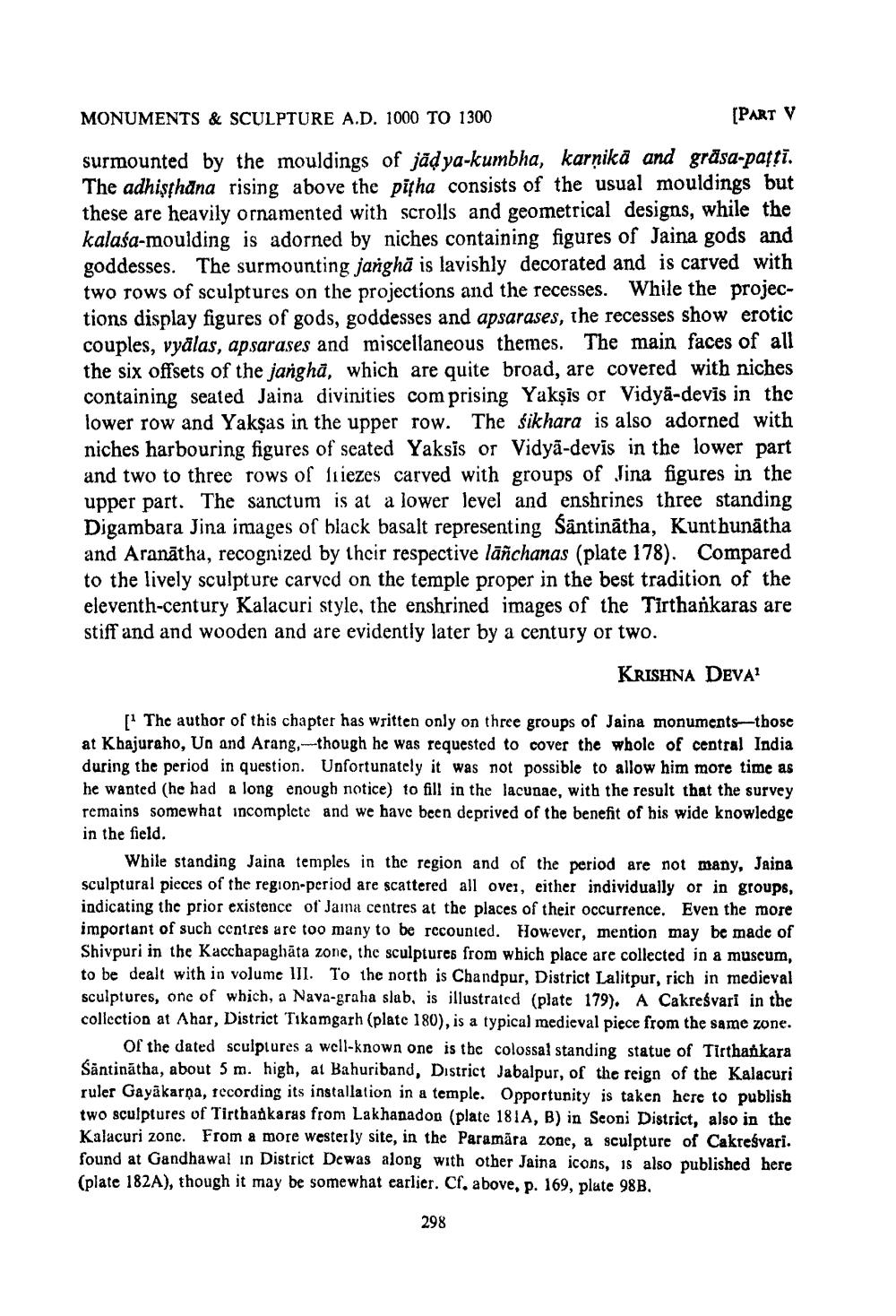________________
MONUMENTS & SCULPTURE A.D. 1000 TO 1300
[PART V
surmounted by the mouldings of jād ya-kumbha, karnikā and gräsa-pafsi. The adhisthana rising above the pitha consists of the usual mouldings but these are heavily ornamented with scrolls and geometrical designs, while the kalasa-moulding is adorned by niches containing figures of Jaina gods and goddesses. The surmounting janghā is lavishly decorated and is carved with two rows of sculptures on the projections and the recesses. While the projections display figures of gods, goddesses and apsarases, the recesses show erotic couples, vyälas, apsarases and miscellaneous themes. The main faces of all the six offsets of the janghā, which are quite broad, are covered with niches containing seated Jaina divinities comprising Yakṣis or Vidya-devis in the lower row and Yaksas in the upper row. The sikhara is also adorned with niches harbouring figures of seated Yaksis or Vidyā-devis in the lower part and two to three rows of liiezes carved with groups of Jina figures in the upper part. The sanctum is at a lower level and enshrines three standing Digambara Jina images of black basalt representing Sântinātha, Kunthunātha and Aranātha, recognized by their respective lāñchanas (plate 178). Compared to the lively sculpture carved on the temple proper in the best tradition of the eleventh-century Kalacuri style, the enshrined images of the Tirthankaras are stiff and and wooden and are evidently later by a century or two.
KRISHNA DEVA?
[ The author of this chapter has written only on three groups of Jaina monuments-those at Khajuraho, Un and Arang.--though he was requested to cover the whole of central India during the period in question. Unfortunately it was not possible to allow him more time as he wanted (he had a long enough notice) to fill in the lacunae, with the result that the survey remains somewhat incomplete and we have been deprived of the benefit of his wide knowledge in the field.
While standing Jaina temples in the region and of the period are not many, Jaina sculptural pieces of the region-period are scattered all over, either individually or in groups, indicating the prior existence of Jama centres at the places of their occurrence. Even the more important of such centres are too many to be recounted. However, mention may be made of Shivpuri in the Kacchapaghāta zone, the sculptures from which place are collected in a muscum, to be dealt with in volume III. To the north is Chandpur, District Lalitpur, rich in medieval sculptures, one of which, a Nava-graha slab, is illustrated (plate 179). A Cakreśvari in the collection at Ahar, District Tikamgarh (plate 180), is a typical medieval piece from the same zone.
of the dated sculptures a well-known one is the colossal standing statue of Tirthankara Säntinātha, about 5 m. high, at Bahuriband, District Jabalpur, of the reign of the Kalacuri ruler Gayäkarna, recording its installation in a temple. Opportunity is taken here to publish two sculptures of Tirtha karas from Lakhanadon (plate 181A, B) in Sconi District, also in the Kalacuri zonc. From a more westerly site, in the Paramāra zone, a sculpture of Cakreśvari. found at Gandhawal in District Dewas along with other Jaina icons, is also published here (plate 182A), though it may be somewhat earlier. Cf, above, p. 169, plute 98B.
298




